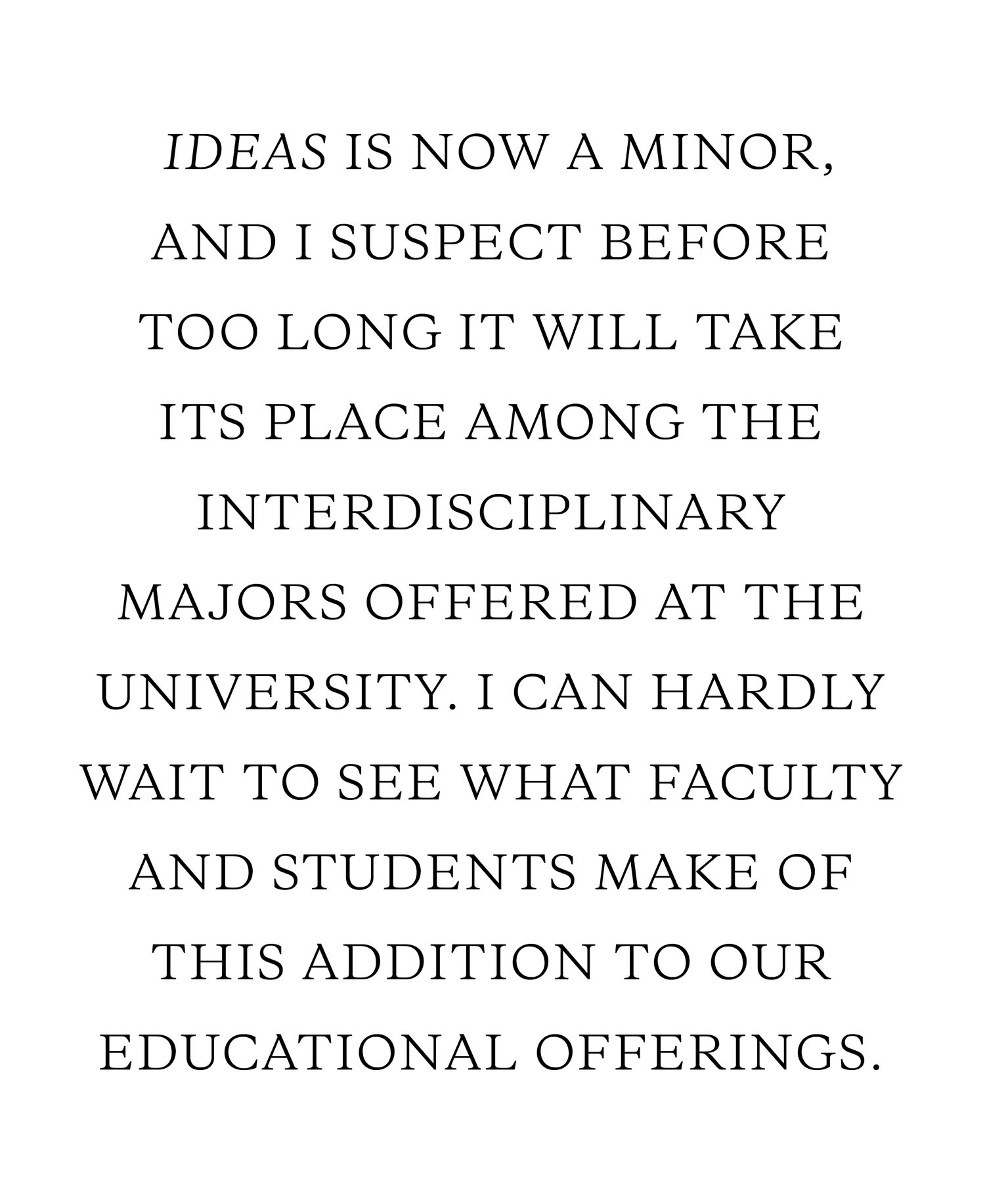President’s Letter: Interdisciplinary Education
IDEAS is now a minor, and I suspect before too long it will take its place among the interdisciplinary majors offered at the university. I can hardly wait to see what faculty and students make of this addition to our educational offerings.”
There is now broad recognition that given the intense interconnection of problems and opportunities in a globalized culture and economy, we require thinkers who are comfortable with ambiguity and can manage complexity. They require an interdisciplinary education. Joshua Boger ’73, P’06, ’09, founder of Vertex Pharmaceuticals (and former chair of the board at Wesleyan University), likes to point out how much creative and constructive work gets done before clarity arrives, and that people who seek clarity too quickly might actually wind up missing a good deal that really matters. Boger preaches a high tolerance for ambiguity because the contemporary world is so messy, so complex.
Tim Brown, CEO of IDEO, one of the most innovative design firms in the world, has lamented that many designers “are stuck with an approach that seems to be incapable of facing the complexity of the challenges being posed today.” He calls for a flexible framework that leaves behind static blueprint preparation for “open-ended, emergent, evolutionary approaches to the design of complex systems [that] can result in more robust and useful outcomes.” Like many CEOs across the country, Brown recognizes that more robust and useful outcomes will come from learning that is capacious and open-ended—from liberal education.
Helga Nowotny, president of the European Research Council, not long ago described what she called the “embarrassment of complexity”—efforts based in data analysis to dissolve ambiguity that lead to more conformity and less creativity. She called for an ethos among business and government leaders that would instead “be based on the acknowledgment that complexity requires integrative thinking, the ability to see the world, a problem or a challenge from different perspectives.” That’s a call for integrative thinking based in liberal learning.
At Wesleyan we recognize this integrative thinking in all the disciplines. The Wesleyan Media Project, which supplies research essential for understanding political advertising, employs researchers with backgrounds in computer science, government, and several other fields. Wesleyans who choose to study design and engineering are embracing creativity. In Design & Engineering, as in many other disciplines (like music and foreign languages), much basic learning is required, but merely memorizing formulae isn’t thinking like a designer. On our campus, some of the most innovative, exploratory work is being done by students studying human-machine interactions, using computer science to manipulate moving images to tell better stories, and exploring intersections of environmental science with economics and performance art. Film and computer science students collaborate on design problems, as do students and career counselors, architects and physicists.
Just a few years ago we created the Digital Design Studio, which seeks to equip students and faculty to address current and future digital design needs in their various disciplines. It’s a place where students interested in art, photography, architecture, graphic design, or theatrical design—to name but a few subjects—can work together in a dedicated digital space and learn to use tools to imagine and test new frontiers. More recently, we facilitated the creation of a student-run arts collective in the basement of Hewitt 8 called the Workshop. It provides space, support, and resources to any student wanting to pursue a creative project; those resources include film and photo gear, computers for design work and film editing, a woodworking bench and power tools, a soldering iron, art supplies, and a sewing machine. As one of the student founders Rachel Day ’16 put it, “when students pursue projects outside of the reward system of grades, they have a huge feeling of ownership and stewardship. It opens up a whole new world of motivations and curiosities; it allows for a lot more exploration—thoughtful fooling around.” It also allows students who may not have considered themselves artistic to develop an interest in arts and crafts. The Workshop is one structure that should spur creativity with respect to “the making of things.”
Obviously (and more importantly) we also have our art studios and our science labs where students certainly “make things.” But while we have applied science here, we have had until recently little engineering per se. Wesleyan faculty committed to the liberal arts have long been suspicious of anything deemed vulgarly vocational. Doubtless many Wesleyan humanists and social scientists (certainly when C. P. Snow was on our campus writing his influential “The Two Cultures”) considered engineers to be mechanistic thinkers always seeking simple answers no matter how complex the problem—and imagined that they were, in turn, seen by engineers as muddled thinkers content with impractical solutions. But that era has passed. Today it’s evident that the making of television shows, headphones, music production, computer games, or technology in the service of community engagement all depend on combinations of design and engineering and the kinds of contextual knowledge provided by the liberal arts. Over the last few years, we’ve made real progress on how to work “the engineering of things” and the attendant satisfactions into the curriculum.
For all these reasons, starting a Design & Engineering program at Wesleyan has been an organic outgrowth of the interdisciplinary education we have long prized. This is a program that will draw on the talents of physicists and architects, graphic designers and chemists. IDEAS is now a minor, and I suspect before too long it will take its place among the interdisciplinary majors offered at the University. I can hardly wait to see what faculty and students make of this addition to our educational offerings.

